Time is ticking, budgets won’t wait, and your team might be spread across different time zones. This is a familiar situation for any company where precise time tracking is critical. Clockify remains a popular tracker, but in 2025, users are increasingly seeking tools with more flexible integrations, advanced analytics, and built-in task management.
We analyzed the market and selected the 10 best Clockify alternatives — from the lightweight Toggl Track to the all-in-one Worksection. In this article, we’ll explain why companies are switching platforms, which selection criteria matter, take a closer look at each tool, and provide a comparison table and answers to frequently asked questions at the end.
Why Do Users Look for Alternatives to Clockify?
Clockify does cover the basic need — time tracking. But business processes have grown more complex in 2025, and teams expect more from their time tracker.
- Limited team functionality. Clockify lacks built-in Gantt charts, Kanban boards, or task prioritization. You have to connect external tools, which complicates your stack and raises costs.
- Weak data visualization. Reports are plain tables and charts, with no customization options. It’s hard for managers to quickly spot bottlenecks and reallocate resources.
- Insufficient automation. While Clockify offers a browser extension and mobile app, it lacks smart tracking that automatically detects what the user is working on. As a result, users have to remember to start/stop the timer, which may distort actual data.
- Outdated UX. The interface hasn’t changed much in years. Navigation can be confusing, and small elements make it harder to use on small screens. New users especially struggle with onboarding.
- Limited access rights. While you can hide projects from clients, you can’t flexibly set internal visibility levels as you can in Worksection or ClickUp.
- Scaling costs. The basic plan is free, but advanced analytics, budgeting, and forecasting require expensive upgrades. Larger teams end up paying as much as for more powerful systems — but with fewer features.
Key Criteria for Choosing a Time Tracking System
Before switching to another platform, define your business goals and match them with market offerings.
- Tracking automation
- User-friendly interface
- Flexible reporting
- Integrations
- Security
- Collaboration tools
- Total cost of ownership
The Best Clockify Alternatives in 2025
Here are 10 tools that can successfully replace Clockify. Each is briefly described to help you quickly assess its strengths and ideal use case.
Worksection
As your team grows, keeping all processes in one place becomes harder. Worksection solves this holistically: it combines Kanban boards, Gantt charts, a calendar, and a built-in time tracker. All features are available on every plan — no need to pay extra for Gantt charts or advanced analytics.
Unlike Clockify, each task functions as a mini workflow with discussions, files, checklists, and time logs. Managers can track logged hours, deadlines, and team workload distribution.

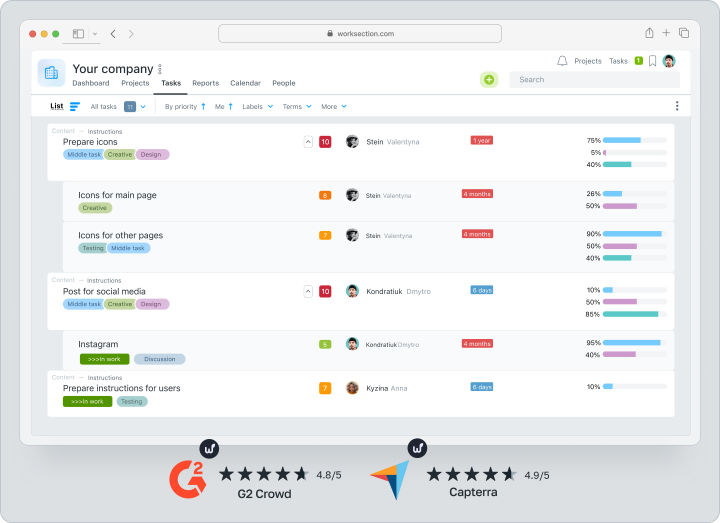
Key advantages:
- Flexible access control — invite clients to selected projects only
- Automatic deadline reminders
- Team workload chart helps spot availability gaps for planning
- Transparent pricing — all features included, no hidden upgrades
Toggl Track
Toggl Track is known for its simplicity: start the timer, work, stop it. Its auto-tracker monitors active windows and suggests logging time if you forget. Reports can be branded and customized for clients. The free plan suits freelancers, while premium plans offer advanced analytics. However, project management features are limited, so teams often pair it with an external task manager.

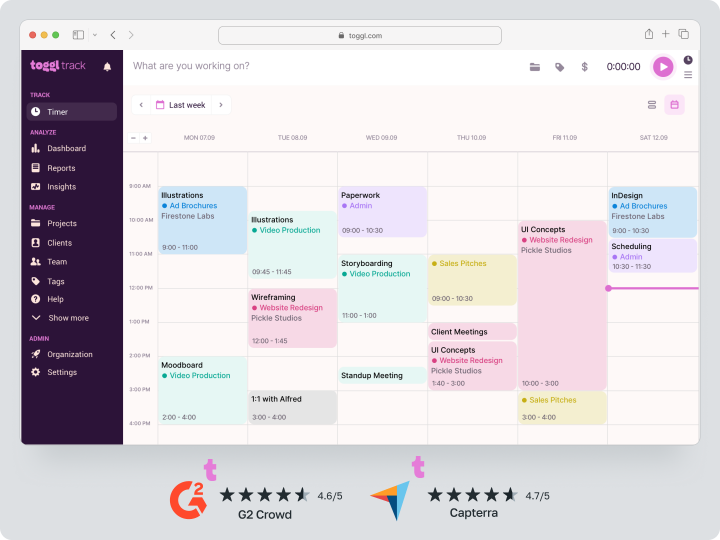
ClickUp
ClickUp brands itself as an “all-in-one” solution: tasks, documents, chats, boards, Gantt charts — and time tracking too. It works well for teams using agile methodologies (Scrum, Kanban, OKR). Custom fields and automations enable complex workflows without code. The downside? A cluttered interface. Beginners may find it hard to navigate the vast number of options.
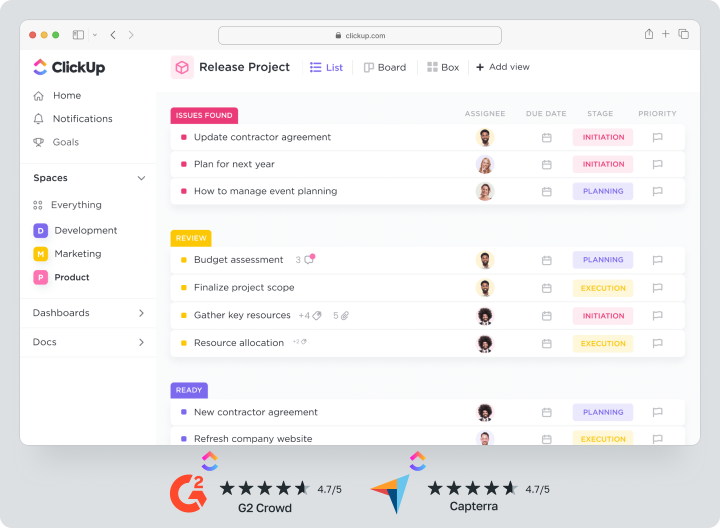
TMetric
TMetric appeals to companies that require strict budget control and hourly billing. It tracks browser tabs, takes desktop screenshots, calculates time costs in USD or EUR, and compares them to project budgets. It includes invoicing and integrates with QuickBooks. Despite the feature set, the interface stays lightweight — switching projects only takes a few clicks.

Everhour
If your team works in Asana, Trello, or Jira, Everhour integrates directly into task cards — no plugins needed. Logged hours are visible within task lists, without switching tabs. The platform supports budget forecasts and Slack sync. The main difference from Clockify is the deep integration: time data appears where the team already works.
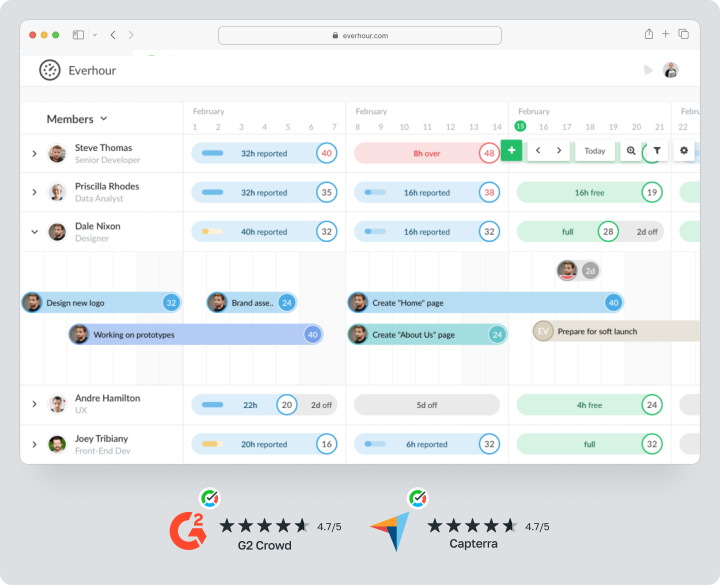
Time Doctor
For distributed teams, productivity monitoring is crucial — and Time Doctor addresses this directly. It takes screenshots, tracks keyboard and mouse activity, and logs website visits. Managers get detailed reports; employees can track their own stats. It also supports automated billing and payroll. If you need monitoring more than project management, Time Doctor may suit you better than Worksection or ClickUp.
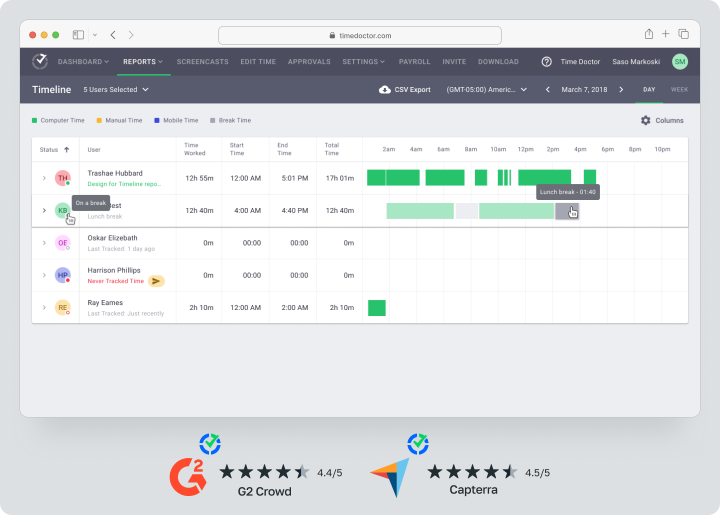
DeskTime
DeskTime combines auto-tracking, productivity analysis, and shift scheduling. It categorizes apps as “productive,” “neutral,” or “distracting” and creates daily focus reports. The “Absence Calendar” module helps shift-based teams log vacation or sick leave. The interface is clean, but its reporting features are more limited than Toggl Track.
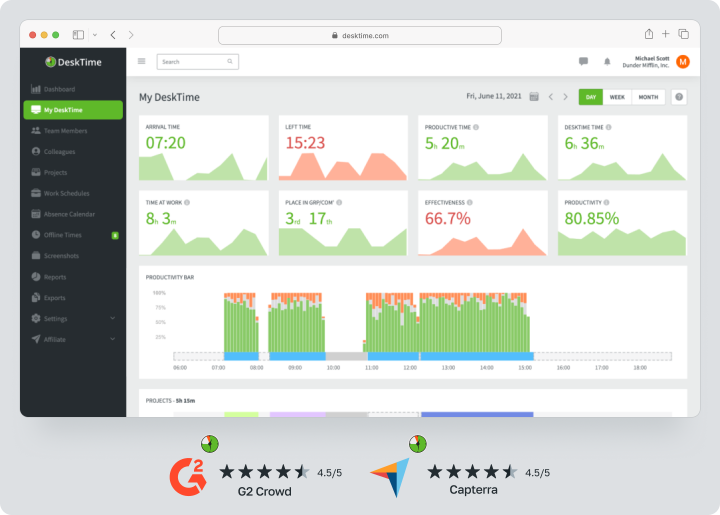
Timely
Timely relies on AI to automatically log user activity by project and task. This means employees get full timesheets without touching a timer, while managers get hourly budget forecasts. It features a visual time timeline and a mobile app for approving logs with a swipe. Downsides? High price — the AI module is more expensive than Worksection or TMetric.
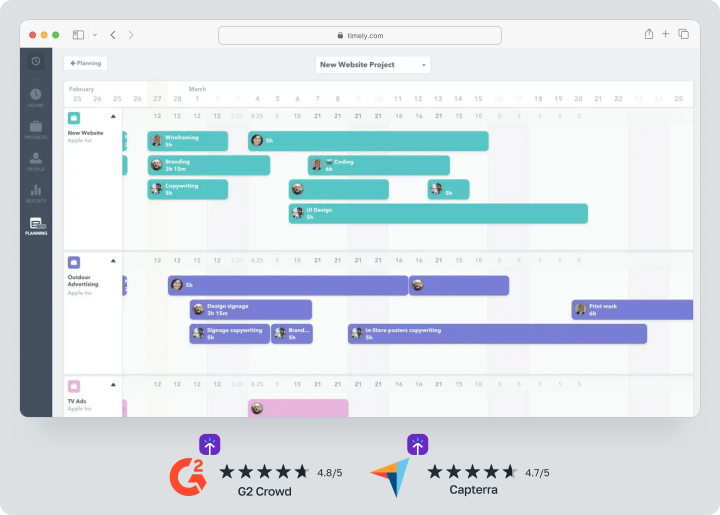
Harvest
Harvest has been around since before time tracking went mainstream and is a freelancer favorite. Its strength is built-in billing: log hours, hit “Create Invoice,” and send it to the client. Integrations with Stripe and PayPal help you get paid faster. However, it lacks Kanban or Gantt views, so task management often requires external tools.
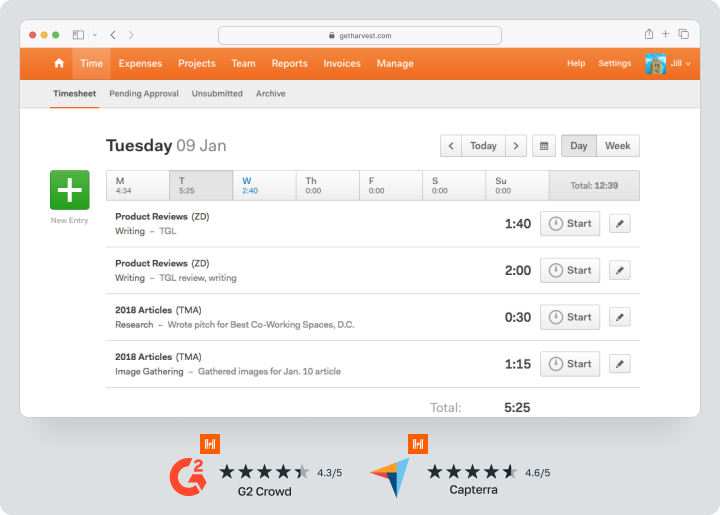
Hubstaff
Hubstaff is built for remote teams and outsourcing agencies. It combines GPS tracking, screenshots, keystroke monitoring, and productivity analysis. It has built-in payroll and supports payments via Payoneer or Wise. If your team works onsite at client locations, Hubstaff shows when they’re there. Downsides include over-monitoring, which may hurt team trust.
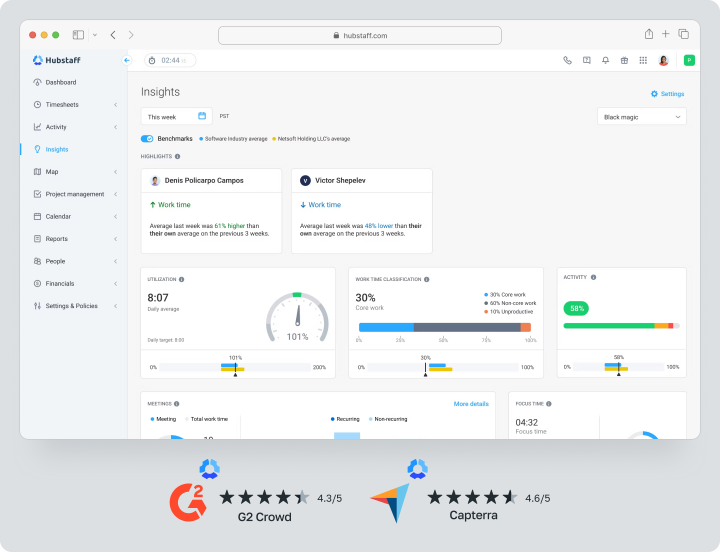
Comparison Table: Best Clockify Alternatives
| Service | Auto Tracker | Task Management | Gantt Chart | Budgeting | Starting Price per User | Key Difference from Clockify |
|---|---|---|---|---|---|---|
| Worksection | Timer + AI/manual | Kanban, list, subtasks | Included on all plans | Projects, budgets, reports | $4.50 | Full features by default, rich visualization |
| Toggl Track |
Yes | Limited | No | Reports | $10 | Easiest UI, powerful reporting |
| ClickUp | Yes | Advanced | Yes | Yes | $7 | All-in-one tool, but interface-heavy |
| TMetric | Yes + screenshots | No | No | Yes | $5 | Budget and hourly rate tracking |
| Everhour | Built-in integrations | Through Asana/Trello | From integration | Yes | $8 | Embedded inside task tools |
| Time Doctor | Yes + screenshots | No | No | Reports | $7 | Detailed productivity tracking |
| DeskTime | Yes | Limited | No | Partial | $7 | App classification by productivity |
| Timely | Full AI | No | No | Yes | $11 | Fully automated time logging |
| Harvest | Timer | Limited | No | Invoicing | $12 | Integrated billing & invoicing |
| Hubstaff | Yes + GPS | Limited | No | Payroll | $7 | Geolocation and payroll out-of-the-box |
Which Platform Should You Choose in 2025?
If your team is small and only needs time tracking, Clockify’s or Toggl Track’s free plans may be enough. But once you manage multiple projects and clients, a basic tracker won’t suffice.
For companies needing full task management, visualization, and collaboration, Worksection is a top choice — Kanban, Gantt, time tracking, and reporting are all included with no extra modules or fees.
- If automated time tracking is your priority, go with Timely.
- For activity monitoring and remote team security, Time Doctor or Hubstaff are logical options.
- If you need hourly billing and strict budgeting, TMetric is a great fit.
- And for freelancers, Harvest remains a convenient tool with built-in invoicing.
Frequently Asked Questions (FAQ)
Which Clockify alternative is best for agencies?
Agencies working with fixed budgets and hourly billing will benefit from Worksection and TMetric. Both allow time tracking by task, setting budgets, spotting overspend, and exporting detailed reports for clients. Worksection also provides Kanban boards and Gantt charts — simplifying planning and coordination.Are there free alternatives to Clockify?
Yes. Toggl Track and TMetric offer free versions with basic time tracking and reports. Limits may apply to projects or users, but they’re often enough for freelancers and small teams. Worksection also offers a free trial so you can explore Kanban, Gantt, and analytics risk-free.
How is Worksection different from Clockify?
Clockify focuses solely on time tracking. Worksection combines a time tracker with full project management: Kanban boards, Gantt charts, a calendar, automatic reports, and flexible access rights — all included in every plan. For teams that value deadlines, visualization, and collaboration, Worksection is a more versatile solution.
Conclusion
Clockify is a solid entry point in the time tracking world, but the demands of 2025 teams go far beyond simple hour logging. If you need automation, flexible analytics, and project management, consider Worksection, ClickUp, or Timely. Agencies will appreciate TMetric and Hubstaff, while freelancers will love Toggl Track’s simplicity and Harvest’s invoicing. The key is to assess your internal workflows, test a few favorites, and choose a platform that will grow with your business.